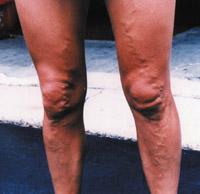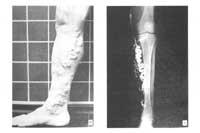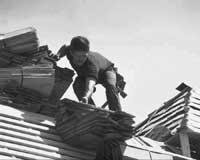How to cope with varicose veins?
2000/03/01 Agirre, Jabier - Medikua eta OEEko kidea Iturria: Elhuyar aldizkaria
The meeting was held in an eminently practical way, addressing four topics in many other seminars: the recurrence of varicose veins (etiology, diagnosis and treatment), ecosclerosis (indications, contraindications and techniques), the surgical technique SESPS (small vein union and surgery of the poplithetical hollow (study, diagnosis and technique of the knee corner).

What are varicose veins?
Permanent dilations of the superficial veins of the legs. Blood normally rises from the feet to the heart through the venous system, but in people affected by this pathology, the malfunction of the venous valves causes the blood to recede creating reflux, which causes a accumulation of blood in the legs, which are the main discomfort and complications of venous insufficiency (varicose veins).
Why do they arise?
Varicose veins are related to human creation. In other words, there are usually no varicose veins in animals (which move on all four legs). The man began to walk upright in his anthropological evolution, reaching the heart the height, which increased the pressure on the legs, dilating the veins or veins and facilitating the appearance of varicose veins.
Varicose veins cannot be considered serious or serious pathologies, but the correct diagnosis is of great importance to avoid pain or the appearance of varicose veins in other areas. Inadequate treatments only delay or delay the problem, as the variz reappears, since its origin has not been resolved.
What causes the disease?
More than bad, varicose veins are symptoms. In principle, men and women have the same possibility of suffering varicose veins, but yes pregnancies, hormonal causes, etc. Therefore, women are seen more. Hereditary causes are very important, but the triggers are many and very different, so there are many types of varicose veins.
What are the symptoms?
Normally the patient confuses pain with variz and does not realize that they are different things. There are people with severe pain without varicose veins in the legs, and others who, having no pain, do not go to the specialist, despite having incredible varicose veins. Thrombosis or other serious complications may occur in the latter.
In addition to pain, the feet and ankles increase, tingling is constant and at night there are cramps or bites of pain.
What are the main therapeutic techniques?
The person affected by variz should immediately go to the specialist (i.e. the surgeon) to assess the therapy to follow. Varicose veins must be operated (removed completely under general anesthesia). Others are treated by radiological techniques, by embolization, by taponamiento in bad condition veins. When the varicose veins are small they sclerosize, that is, a medicine is injected inside the varicose veins and also the foam, which causes sclerosis of the variz, hardens and closes the variz, recirculates the blood and prevents reflux. As for the laser, it is a new, non-invasive technique, which in some cases can be a suitable solution but not always.
And what prevention?
As seen above, there is a genetic predisposition to varicose veins, but it is intimately linked to the habits of life and in this pathology obesity, sedentary lifestyle, as well as the profession that forces us to perform long periods of standing or sitting have a very negative incidence.
According to specialists, it is essential to comply with hygienic-dietary and postural measures to prevent and control venous disease. To combat this tension felt in the legs it is very important to exercise often and especially gymnastics, as at home.
Some tips
- Do not wear clothes that tighten the lower body or high heels.
- Maintain proper body weight.
- Do not use alcohol or tobacco.
- Taking oral contraceptives only by prescription.
- Do not spend too much time in the sun or take excessively hot baths.
- Take every day cold water baths (10-20 seconds) on each leg from the ankle up.
- Talk to your doctor if you should wear elastic socks but if they are well measured.
- Exercise at home. At the end of a massage with the palm of the hand, from the foot to the thigh.
- Swimming and cycling are recommended if possible.
- Walk as much as you can, at least half an hour a day.
- Do not stand for a long time. Rest 20 minutes every hour, try to keep your legs up and give a small massage.

Gai honi buruzko eduki gehiago
Elhuyarrek garatutako teknologia






